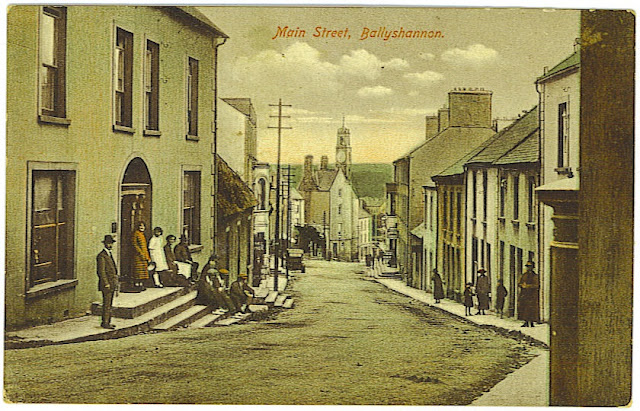- The town had a distinctive clock on the newly built Belfast Bank which was built in 1878 at a cost of £4,000. This building later became the Royal Bank. In the 1960s the Royal Bank amalgamated with the Provincial Bank which was next door and the two banks merged into Allied Irish Bank. (A.I.B.) which still operates as a bank today. The building with the clock then became a jewellers. The clock was restored to its former glory in November 2019 thanks to the work of Ballyshannon Regeneration Group, the new owner of the premises Eamon McNulty and the local community.
- There was a Market House close to O'Reilly's Fish Shop. Courts were conducted in the Market House and there was also a dispensary and social activities in the building. The Market House was tossed in living memory. This is an open recreation area today used for craft fairs and music events.
- The Workhouse was still operating on the Rock beside the Church. The building still survives today but is in a dangerous condition. Sad. The Famine Orphan Girls memorial the only one of its type in Ireland, is open at all times to the public, beside the workhouse and just opposite the main entry to Fr. Tierney Park. It names and remembers 19 orphan girls shipped to Australia from Ballyshannon workhouse at the height of the Famine. The girls were from the areas around Ballyshannon including Kinlough, Belleek, Mulleek and the Ballyshannon area. Why not pay a visit to keep the memory alive?
- The Great Northern Railway was thriving on Station Road and there were two trains to Dublin daily. The railway arrived in Ballyshannon 150 years ago in 1867. One hundred and fifty years ago the Sisters of Mercy also arrived in Ballyshannon and are still here today. The G.N.R. railway closed in Ballyshannon 62 years ago in 1957. Two years later in December 1959 the County Donegal Railway in Ballyshannon closed. A great railway town.

The GNR station in Ballyshannon - There were 6 churches open in town- 2 Catholic, 1 Protestant, 1 Presbyterian and 2 Methodist. The second Methodist Church was at the top of the Main Street. Today there are three churches in town.
- The town had another iconic clock thanks to the St. Anne's community and the peal of the bells is part of Ballyshannon's heritage. Still has been a regular, welcome and much appreciated sound in 2020. The church which is lit up at night is a welcome beacon for people coming home or passing through town. St. Patrick's Church and St. Joseph's Church also have welcoming bells. which all form part of the town's heritage.
- There were 2 Markets every week in the Market Yard on Thursdays and Saturdays where farmers could sell their produce. The car boot sale takes place in the general area today.
- Fairs were held on the second day of each month. The Harvest Fair was held on the 16th September and was the biggest social gathering of the year. The cattle, horse and pig fairs were held in and around the Fair Green which today is Allingham Park. Cattle are now sold in the Mart on Station road.
- The Donegal Independent on the Mall and The Donegal Vindicator on the Port were two newspapers carrying on the tradition of the oldest newspaper town in County Donegal begun in 1831. The Donegal Democrat (still in existence) was founded in Ballyshannon in 1919 and was the last paper to be printed in Ballyshannon.
- There was a Coastguard Station, a Brewery and an Excise Office which all harked back to the days of shipping from the Mall Quay in the town. In modern times a micro-brewery has been opened at Dicey Reillys and who can say what other revivals there will be? The Coastguard houses are still visible at West Rock as are warehouse at Mulligans on the Mall and the Distillery buildings visible from the new footbridge.
- Like most towns in Ireland, craft trades have disappeared since 1889 including; tanners, boot and shoemakers, weigh-masters in the Market Yard, saddlers, cart makers, hide and butter merchants and Rogan's world famous fly-tying . In modern times good to see a number of craft shops and other new business premises opening in the town.
So that you can get your bearings in 2020 the old barracks is occupied by Diarmaid Keon (DKP) auctioneers, a computer shop and Mr. G's today. The premises of Robert Sweeney listed below were located where the Bank of Ireland is today. P.B. Stephens' ‘emporium’ is where Mary McGuinness has the town’s excellent bookshop called ‘A Novel Idea’. Read on to see the businesses up the town.
 |
Ideal Local gift for Christmas home and away. Limited edition quality hardback with dust jacket as above available in A Novel Idea and Local Hands Ballyshannon and Four Masters Bookshop Donegal Town. Also available signed copies, and inscriptions, for postage or collection from anthonyrbegley@hotmail.com |









